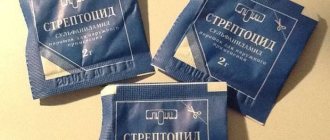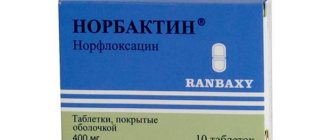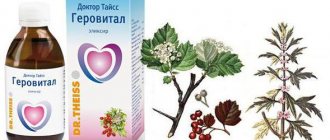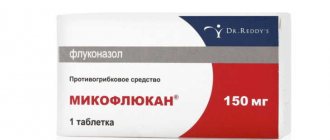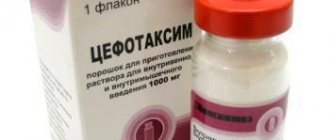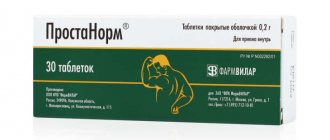Theophylline (Theophyllinum lat.) is a purine derivative, an alkaloid, an adenosinergic agent, known as a central nervous system stimulant, with antispasmodic, bronchodilator, antiasthmatic, cardiotonic and pronounced diuretic properties.
This purine derivative is produced in well-packaged containers that protect the main active ingredient - Theophylline - from direct exposure to light.
Theophylline release forms:
- oral tablets Theophylline anhydrous – (100 mg, 200 mg); depot (200 mg, 300 mg); retard (100 mg, 250 mg);
- powder in capsules – (50 mg, 75 mg, 100 mg, 125 mg, 200 mg, 300 mg);
- rectal suppositories 0.2 g;
- syrup (Elixir) (15 ml - 80 mg).
Theophylline tablets
Theophylline anhydrous tablets (flat-cylindrical with a chamfer) are coated with a soluble coating, or can be produced without it. Packaged in blisters (cell packaging) and in plastic container jars.
The active substance in one tablet is from 100 to 300 mg.
“Depot” and “retard” are not the names of tablets! This is a compressed form of Theophylline powder containing the main medicinal substance Theophylline. It dissolves in the stomach layer by layer, allowing the medicine to enter the body gradually, in doses - a prolonged form of obtaining the medicine. Depono (lat.) – to postpone, retardo (lat.) – to slow down.
This form is the most attractive for the patient, because it ensures a stable concentration of the drug in the body, eases the load on the gastrointestinal tract and significantly reduces the negative consequences if the drug was not taken on time or was completely forgotten.
Capsule and powder form of the drug
Anhydrous Theophylline capsules are a drug of modified action, that is, combining the speed of onset of the therapeutic effect and the duration of exposure.
Theophylline powder is packaged in a hard gelatin shell with 3 colors for easy determination of drug quantity. So:
- white-pink capsule (white or colorless body and pink cap) – 100 mg;
- white-blue capsule – 200 mg;
- capsule No. 1 white-green – 300 mg.
Theophylline in powder form
Theophylline suppositories
Theophylline rectal suppositories are suppositories containing 0.2 g of theophylline, the rest is a fat base in which the drug is distributed evenly.
Such bases melt under the influence of body temperature, ensuring maximum availability of the medicinal substance through the mucous membrane, having the ability to easily pass from a solid state to a liquid state, bypassing the “ointment-like” state.
Rectal suppositories Thiophylline
Theophylline suppositories are the least toxic, practically do not cause allergies, and dissolve within an hour. One package contains 10 per rectum suppositories with theophylline.
Syrup
Theophylline syrup
Theophylline in elixir form is often called "syrup". Theophyllinum elixir has a trade name - Theophylline KI. The generic (international) name is complex - Theophylline/Potassium Iodine (Theophylline-potassium iodide). It is called syrup because of the high sugar content in the orange solution and the orange-citrus taste and smell pleasant for children.
This elixir has a significant advantage over other forms of Theophylline - it is available for use by children from 1 year old, while, like other forms, it is not earlier than 6 or 12 years.
Reviews
Information about this substance can be viewed from two sides. Therefore, first you need to understand how theophylline , what it is and what effect it has on the human body. Theophylline originally discovered in tea leaves and is similar in chemical structure to caffeine , although, unlike it, it exhibits different effects. The beneficial effects of tea on diseases of the lungs , cardiovascular system and other painful conditions have been known for a long time, and although the amount of theophylline in tea is quite small, it is certainly one of the components of the positive effect of this drink on the human body.
theophylline appeared , that is, a chemical used in medicine. Reviews from doctors about this drug, although not excellent, are often positive, with mention of some side effects . The thing is that the advisability of prescribing Theophylline can only be assessed by a doctor who has not only knowledge, but also sufficient experience. For example, the long-acting tablets we are considering are not suitable for relieving attacks , whereas with long-term therapy they can show excellent treatment results. You should also take into account medical history , concomitant diseases, individual sensitivity , taking other medications and much more, which is impossible for a person to do without appropriate training. In this regard, a doctor should prescribe therapy, and then the drug Theophylline will show all its positive sides.
Pharmacological action of Theophylline drugs
Since the drug theophylline is an alkaloid, its highest content is in tea leaves and coffee beans. It is known that the action of this substance is dilation of the coronary vessels of the heart, relaxation of the muscles of the bronchi, stimulation of the nervous system and a diuretic effect.
Nowadays, such a derivative of purine and xanthine is obtained synthetically, which has made Theophylline available to everyone.
Use of alkaloids in medicine:
- Improving coronary circulation in angina and chronic coronary insufficiency.
- Treatment of cough of various etiologies.
- With congestion of cardiac and renal circulation - edema.
Theophylline, in combination with other drugs, copes well with all these tasks. For example, it enhances the convergence of edema in combination with cardiac medications. The effect is higher than that of theobromine (cocoa bean alkaloid). And in combination with Teofedrine it is used to treat bronchial asthma during bronchospasms.
Drug interactions
Theophylline increases the risk of side effects of drugs that excite the central nervous system (increases neurotoxicity), drugs for general anesthesia (the likelihood of ventricular arrhythmias increases), glucocorticosteroids, mineralocorticosteroids (hypernatremia is possible).
Enterosorbents and antidiarrheal drugs reduce the absorption of theophylline.
If concomitant use of anticoagulants is necessary, extreme caution should be used.
Theophylline, when administered in combination, reduces the effectiveness of lithium preparations and beta-blockers, enhances the effect of diuretics and beta-adrenergic stimulants.
An increase in the severity of the effect of theophylline (which requires a reduction in its dose) may be observed in the case of simultaneous use of P450 inhibitors (including lincomycin, cimetidine, allopurinol, fluoroquinolones, macrolide antibiotics), recombinant interferon alpha, methotrexate, mexiletine, disulfiram, thiabendazole, verapamil, ticlopidine, enoxacin, propafenone, isoprenaline, as well as during influenza vaccination.
Theophylline is compatible with antispasmodics. It should not be used simultaneously with other xanthine derivatives.
An increase in the clearance of theophylline (which requires an increase in its dose) may be observed in the case of simultaneous use of oral estrogen-containing contraceptives, moracizine, sulfinpyrazone, carbamazepine, isoniazid, phenytoin, phenobarbital, rifampicin, aminoglutethimide.
Mechanism of action
By enhancing MCC (Mucociliary clearance) by stabilizing the mast cell membrane, Theophylline affects:
- on the functions of the respiratory and intercostal muscles, increasing contractions of the diaphragm;
- stimulating the respiratory center - normalizes breathing, increases the secretion of adrenaline by the adrenal glands.
This promotes oxygen saturation of the blood and other organs, reduces the concentration of carbon dioxide and increases ventilation of the lungs.
In turn, this action has a positive stimulating effect on the heart, increasing the strength and frequency of heart contractions, ensuring the supply of oxygen to the myocardium.
Effect of use:
- the tone of the blood vessels of the brain, kidneys (diuretic effect) and skin decreases;
- pulmonary vascular resistance decreases;
- the contractile activity of bronchial smooth muscles decreases;
- the pressure in the pulmonary circulation decreases;
- the superficial function of the left and right heart ventricles improves.
Theophylline is used as the main drug (for broncho-obstructive syndrome), and as an adjuvant for other diseases (edematous syndrome of renal origin).
Indications for use of Theophylline
The main areas of use of tablets, capsules and suppositories of 1,3-Dimethylxanthine (chemical name Theophylline):
- Emphysema.
- Development of chronic obstructive bronchitis.
- Pulmonary hypertension.
- Pulmonary heart and pulmonary hypertension.
- Sudden stops in breathing during sleep - apnea.
- Bronchial asthma.
- Edema syndrome of renal origin (in complex).
Indications for the use of Theophylline KI elixir for children under 3 years of age: ATC category - bronchodilator and expectorant (mucolytic, bronchodilators).
The packaging of a medicinal product of any release form contains instructions with a detailed description of the drug itself and recommendations for its use, as well as other useful information that is important to study before starting treatment.
special instructions
According to the instructions, Theophylline is not intended for the relief of emergency conditions.
Treatment should be carried out under monitoring of the concentration of the drug in the blood.
If bronchial asthma can be controlled, there are no side effects, and there are no factors that could lead to a change in the need for the dose of the drug, it is enough to measure theophylline concentration every 6-12 months.
During treatment, you should not consume large quantities of caffeine-containing drinks and foods.
Method of administration and dosage of the drug
Theophylline is dispensed from pharmacies with a doctor's prescription.
This is due to an individual approach for each patient in calculating the dose and the doctor’s confidence, after passing certain tests, in the tolerable tolerability of the drug.
Common doses of Theophyllinum are:
- the initial dose should not exceed 400 mg of 1,3-Dimethylxanthine per day;
- the dosage can be gradually increased by 25% over 3 days;
- When the therapeutic effect is achieved (4–5 days), it is advisable to stop the increase.
The doctor must decide whether to stop or continue use.
Theophylline dosage in blood plasma, which should not exceed mg/kg per day:
- from 20 to 25 kg – 24 mg/kg;
- from 24 to 32 kg – 20 mg/kg;
- from 50 to 70 kg – 18 mg/kg;
- from 70 – 13 mg/kg.
Overdose
In case of an overdose of Theophylline, the following were observed: loss of appetite, diarrhea , gastralgia , nausea leading to vomiting (possibly with blood), gastrointestinal bleeding . Ventricular arrhythmias , facial hyperemia, tachypnea , tachycardia . Insomnia , anxiety, motor agitation, tremor , photophobia, convulsions . In case of severe overdose, the development of epileptoid seizures (especially in childhood), hypoxia , confusion hyperglycemia , metabolic acidosis, hypokalemia , necrosis of skeletal muscles, decreased blood pressure , renal failure with myoglobinuria is possible.
Recommended treatment consists of drug withdrawal, gastric lavage, laxatives, activated charcoal , and colon lavage using electrolytes and polyethylene glycol . Also indicated are forced diuresis , plasma sorption , hemosorption , possibly, but ineffectively, hemodialysis , and the prescription of symptomatic therapy. In case of severe nausea and vomiting, intravenous administration of ondansetron or metoclopramide . In case of convulsions, it is necessary to ensure and monitor the patency of the airways, and also administer oxygen therapy . The seizure is stopped by intravenous administration of 0.1-0.3 mg/kg Diazepam , but not more than 10 mg.
Contraindications to the use of Theophylline
Intolerance to purine derivatives, stroke, heart attack, hemorrhage (including peptic ulcer), atherosclerosis of the coronary arteries, pregnancy and lactation.
Contraindications to the use of Theophylline
Analogs and trade names of the drug:
- Theotard;
- Afonilum;
- Spophylline retard;
- Teobiolong;
- Theodile;
- Ventax;
- Teopek;
- Theotard;
- Uni-dur;
- Uniler;
- Diffumal;
- Eufillin;
- Spophylline;
- Retafil.
| A drug | Photo | Price |
| Theotard | from 142 rub. | |
| Eufillin | from 11 rub. | |
| Teopek | from 218 rub. |
Theophylline has a number of generics - this is how medications are usually called for which the official patent period (patent protection) has expired.
Generics are famous for their lower price compared to patented drugs, but the price of Theophylline is already low (about 200-300 rubles per pack).

